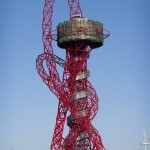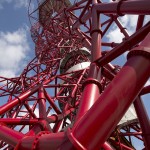The main ingredients of this project are a mythical and ambitious metropolis – London; one event – the Olympic Games; a dynamic and ambitious mayor – Boris Johnson; a very powerful corporation – ArcelorMittal and its Chair – Lakshmi Mital; a cooperation between an exceptional artist (and always appealing to a broad audience) – Anish Kapoor and a visionary engineer – Cecil Balmond.
If the Guggenheim Museum in Bilbao also works as a museum, and the “Bird’s Nest” in Beijing truly hosts competitions, then Orbit has no means but itself. It is a work of art – the tallest sculpture in the UK, and the only function is to offer platforms (quite large, that’s true) to view the panorama.
The success to the public cannot be assessed yet; it’s worth talking though, I think, about the reasons and the mechanisms of such an action and why the cities need these kind of gestures as well.
Text : Stefan Ghenciulescu / Photos : © ArcelorMittal
The mayor
The Olympic Games costs many billions (in any currency you want). It is vital, when you make such an investments, for the money to continue to flow after the event is over (an event which, obviously, is never self-supported). The equipment remains, of course, but people need to be further attracted. For Mayor Boris Johnson, the regeneration of the Olympic area also implied pushing for touristic attractiveness. Orbit is, obviously, an event signpost – the same way Eiffel Tower was for the International Exhibition in 1889, but it also needs to become first of all a catalyser of tourism in the area and an identity element. Actually, Eiffel Tower as a model (to be excelled) through the initial theme was explicitly recognized by its authors . Although this is not talked about, the work, very probably, also a sign of optimism and security in conditions of a never-ending crisis. We keep on going, we’re good, and have faith and courage… a vital message for investors, but also for community and for the international public opinion.
The sponsor
For any iconic project, one needs a lot of money. Approached by Mayor Johnson, Lakshmi Mittal immediately agreed to participate. The steel used comes of course from the production of the corporation (2,000 tones, out of which 57% is recycled). What smarter advertising one could wish for? ArcelorMittal (already one of the most important sponsors of the Olympic Games) contributed with 19,6 million sterling pounds out of 22,7, the cost of that construction.
The authors
The competition was not won by an architect, but the proposal of a sculptor and of an engineer. Truly, this is about a sculptor who first works with the space (let’s remember the wonderful Leviathan from Monumenta last year – see Zeppelin 96) and about one of the few today’s engineers who sublimates structural design into art and who is seen as co-author of some of the most important works of architecture in the last years. Kapoor and Balmond also worked together, among others, at Marsyas (the installation at Tate Modern), and Arup, the mythical company in which Balmond worked for years and years, takes part in the project.
The object. First of all, a gigantic sculpture
Kapoor and Balmond don’t take Eiffel Tower as the only reference, but also Babel Tower or Tatlin’s uncompleted project for the 3rd International. Balmond also talks about a “cloud of electrons” and their constant concern about nonlinear structures using “instabilities as stabilities”. The obsession of a relationship between continuity and non-continuity, between exterior and interior is constant in Kapoor’s works, and, similarly to Balmond’s programmatic thinking of 3D structures. The project is spectacular and enigmatic, complex and, certainly, an outstanding structural achievement: a building pushing forward technological progress and, definitely, architecture in general. However, it somehow seems to remain a brilliant technical solution of a formal concept. The coherence between space, form and structure, obvious at Eiffel Tower, for instance, but also in a lot of Anish Kapoor’s previous achievements, is less strong in this case: it is difficult to realize if all parts have a structural role or if that was the most rational structural solution. Also, it is a bit frustrating that visitors will only go through a very small part of the curve; the rest if pure volume.
Waiting to see if it was worth doing
Organizers estimate one million visitors in the first year. We?ll have to see if Orbit can go in the group of iconic buildings, such as those mentioned above, also including the Opera in Sydney, or Eero Saarinen’s Gateway Arch in Saint Louis. Celebrity always turns profitable, gradually, at levels impossible to be assessed. At a more modest level, it is interesting to notice if Orbit will manage to contribute to the urban development of that part of London. Gateway Arch was thought as a motor of urban regeneration from the very start (during the Great Depression, when the idea came up). It then lasted for 35 years since the first launch, it cost enormously, yet it worked. Today, it is visited by more than four million visitors per year.






